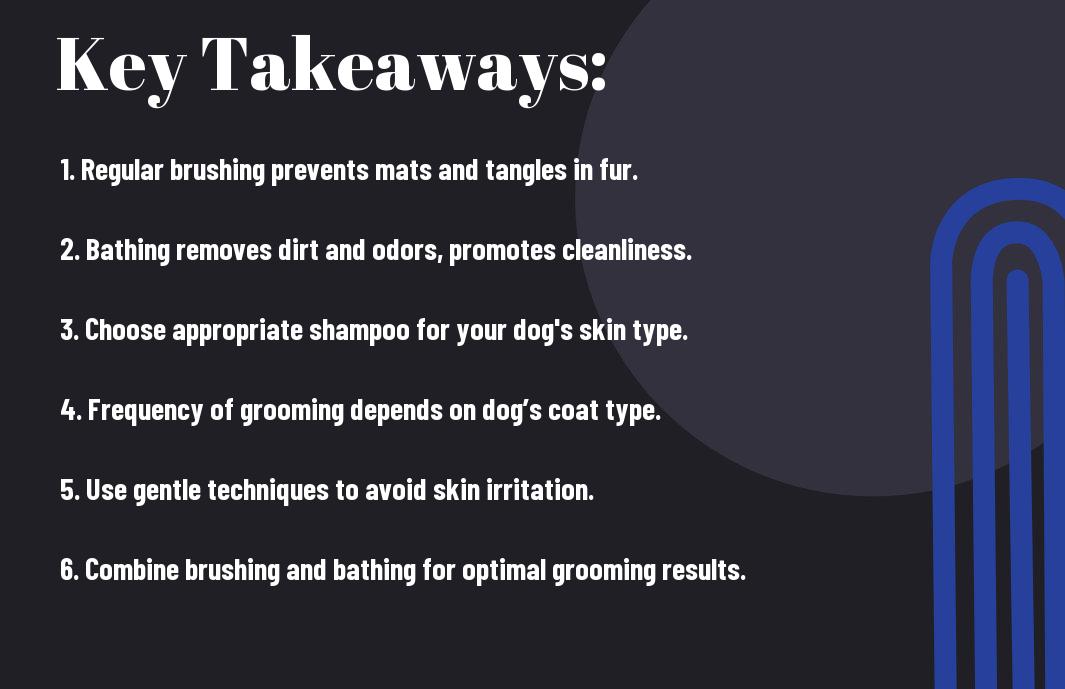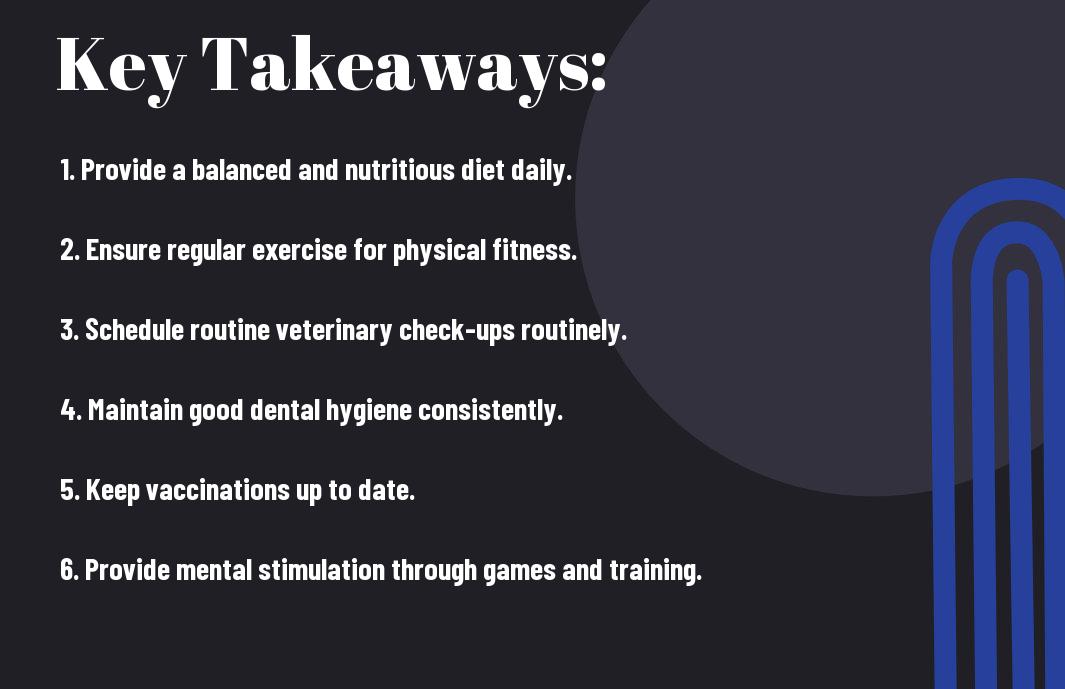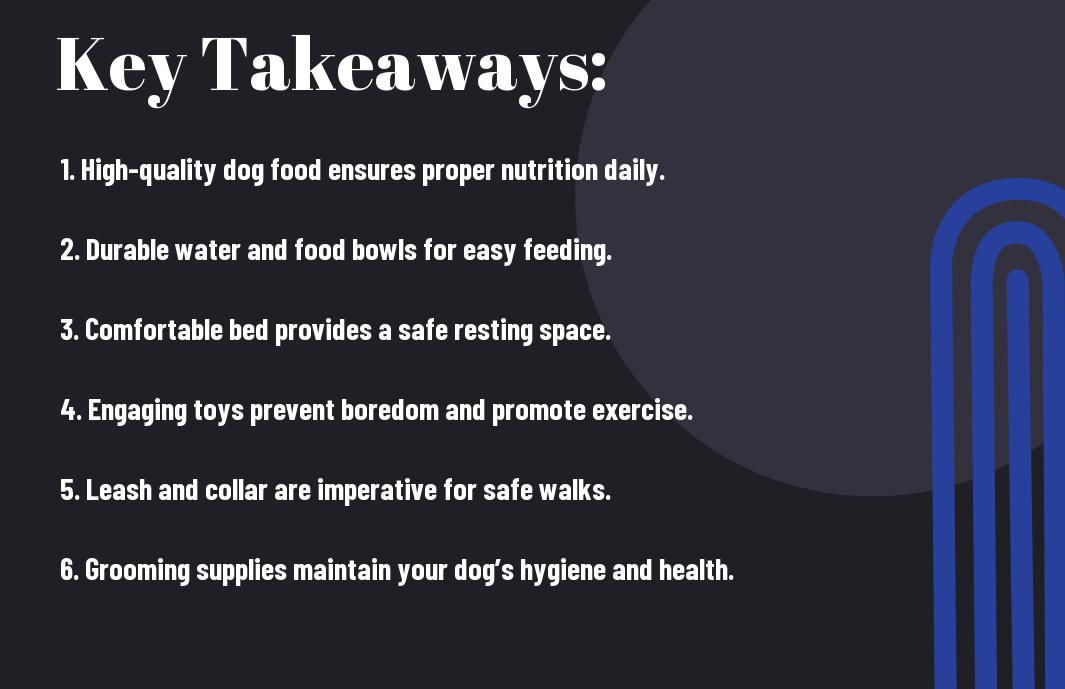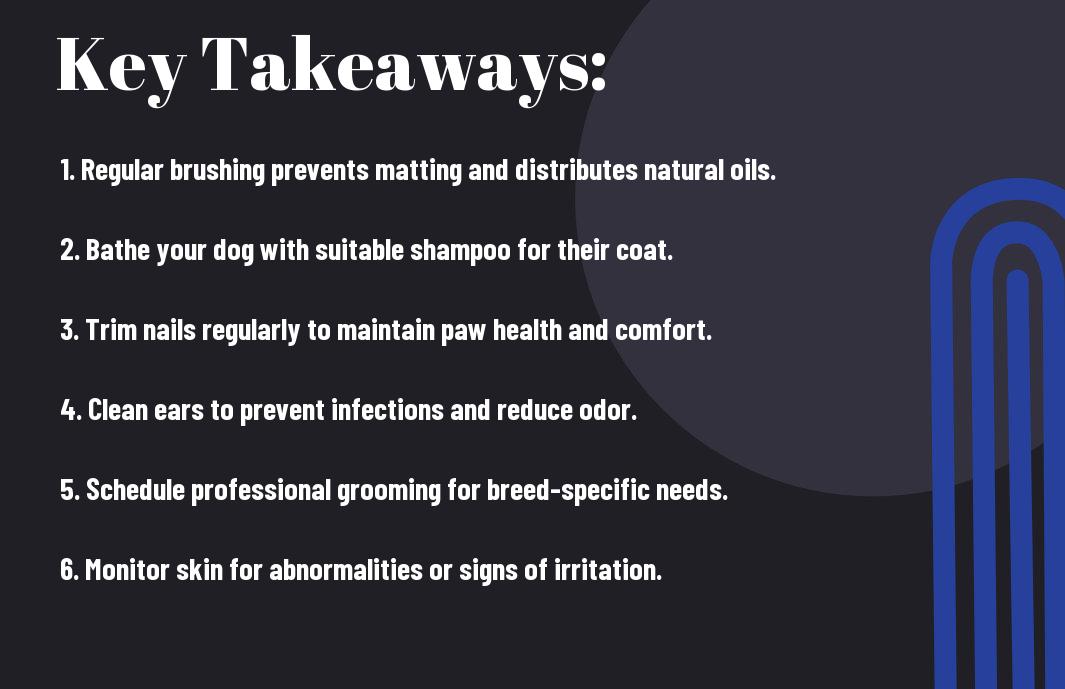Grooming your dog is not just about keeping them looking their best; it’s imperative for their overall health and well-being. In this informative post, you’ll learn the key differences between brushing and bathing, two fundamental aspects of dog grooming that cater to your pet’s unique needs. By understanding when and how to employ these grooming techniques, you can ensure your furry friend stays clean, comfortable, and happy.

Understanding Dog Grooming
For any dog owner, understanding the fundamentals of dog grooming is necessary for ensuring your furry friend remains healthy and happy. Grooming goes beyond mere aesthetics; it is about maintaining your dog’s overall well-being. Regular grooming not only helps in keeping your dog’s coat clean but also facilitates early detection of potential health issues like skin infections or parasites. Knowing how to effectively groom your dog can lead to a more enjoyable experience for both you and your pet.
Importance of Grooming
Below are several key reasons why grooming should be an integral part of your dog’s routine. Firstly, regular brushing helps remove loose hair, dirt, and debris, which reduces shedding and keeps your home cleaner. It also stimulates the skin and promotes the production of natural oils, ensuring a shiny and healthy coat. Additionally, grooming sessions can serve as bonding time between you and your dog, helping to build trust and reinforce your relationship. Moreover, it allows you to examine your dog for any abnormalities, such as lumps or skin irritations, which you might otherwise overlook.
Different Grooming Techniques
Importance lies in understanding the diverse grooming techniques available to suit various dog breeds and coat types. Each breed has specific grooming needs; for instance, long-haired breeds may require daily brushing to prevent matting, while short-haired breeds can often get by with a weekly brush. Bathing frequency also varies; dogs with oily coats may need more frequent washes than those with dry coats. Furthermore, techniques such as nail trimming, ear cleaning, and teeth brushing are all part of a comprehensive grooming routine that supports your dog’s health.
Even within basic grooming, techniques can vary widely. For example, you may choose between using a slicker brush or a comb for your dog’s coat based on its texture. Additionally, some dogs require specialized grooming tools, such as de-shedding tools for double-coated breeds, while others might benefit from a grooming glove for a gentler approach. Understanding these various techniques will empower you to select what works best for your dog, ensuring a comfortable and effective grooming experience.
The Benefits of Brushing
Assuming you have a dog, grooming is an imperative part of maintaining their overall health and appearance. Brushing your dog’s coat has multiple benefits that go beyond just aesthetics. Regular brushing helps to reduce shedding, minimize matting, and remove dirt and debris that can accumulate in their fur. Additionally, it promotes a healthy skin environment by distributing natural oils, leading to a shinier and more vibrant coat. Brushing can also serve as a bonding time between you and your dog, allowing you to check for any lumps, bumps, or irritations that may require veterinary attention.
In understanding the importance of brushing, you might find that the type of brush you use plays a significant role in its effectiveness. Different breeds and coat types require specific types of brushes to achieve the best results. Additionally, brushing your pet regularly can also help reduce allergens in your home, contributing to a cleaner living environment.
Types of Brushes
| Brush Type | Best For |
| Slicker Brush | Long-haired dogs, detangling |
| Bristle Brush | Short-haired dogs, reducing shedding |
| Undercoat Rake | Double-coated breeds, removing loose undercoat |
| Rubber Brush | Short hair and sensitive skin, massage |
| Comb | Detangling small areas, fine-tuning grooming |
- Choose the right brush for your dog’s breed and coat type.
- Brush with the direction of hair growth.
- Make it a positive experience with treats.
- Pay extra attention to common matting areas.
- Perceiving the grooming process as part of playtime can make it enjoyable for you both.
Frequency and Technique
Types of grooming frequency will largely depend on your dog’s breed, coat length, and lifestyle. For example, long-haired dogs generally require more frequent brushing—ideally every day—to prevent matting, while short-haired breeds may only need brushing once a week. However, regardless of your dog’s coat type, establishing a consistent grooming schedule can help you manage shedding and keep your dog comfortable. Techniques such as sectioning off your dog’s coat while brushing and employing a gentle touch can make the process more effective and enjoyable, both for you and your pet.
Understanding how often to brush your dog and the right techniques is vital for effective grooming. When brushing, ensure you pay attention to sensitive areas, such as behind the ears and around the tail. Using slow, deliberate strokes can help ease any discomfort, especially for dogs that might be less tolerant of grooming. If you notice any mats, take the time to gently work them out rather than pulling at your dog’s fur, which could lead to more significant discomfort. Regular brushing serves not only as maintenance for your furry friend but also as an opportunity to show love and care, ultimately contributing to their overall well-being.

The Benefits of Bathing
Unlike brushing, which primarily addresses coat health and removes loose hair, bathing is fundamental for maintaining your dog’s overall hygiene. Regular baths help wash away dirt, debris, and allergens that can accumulate on your pet’s skin and coat. This not only results in a cleaner dog but also helps prevent skin infections, irritations, and other health issues that can arise from poor hygiene. Additionally, bathing can help reduce unpleasant odors, making your furry friend more enjoyable to be around during cuddle time or playtime.
Bathing can also create a precious bonding experience between you and your dog. The process of bathing can calm anxious pets, allowing them to relax in your presence. This time spent together enhances your relationship and builds trust, imperative elements in dog training and companionship. Furthermore, many dogs come to love bath time, eagerly anticipating the attention and affection it entails.
Choosing the Right Shampoo
One of the most important aspects of bathing your dog is selecting the appropriate shampoo. Different dogs have varying skin types and sensitivities, so it’s important to choose a shampoo that caters to your dog’s specific needs. For instance, if your dog has sensitive skin, look for hypoallergenic formulas that are free from harsh chemicals. On the other hand, a soap alternative might work well for dogs prone to irritation and allergies. Always consult with your veterinarian if you’re uncertain about which products to select.
Additionally, some shampoos are specially formulated to target specific issues—such as flea control or odor removal—so you may need to choose based on your dog’s lifestyle. You should avoid human shampoos, as they can disrupt the pH balance of your dog’s skin, leading to dryness and irritation. Opt for a dog-specific shampoo that ensures your furry friend remains clean and comfortable during and after bath time.
Bathing Frequency and Method
An imperative aspect of dog grooming is understanding how often to bathe your pet and the best techniques for doing so. The frequency of bathing can depend on several factors, including your dog’s breed, lifestyle, and specific skin conditions. Generally, most dogs benefit from a bath every month, but active or outdoor dogs may require more frequent cleaning. Conversely, dogs with less active lifestyles may only need a bath every few months. Observing your dog’s overall condition will help you determine the right schedule.
Understanding the correct method for bathing your dog is important for ensuring an effective wash while minimizing stress for both you and your dog. When bathing, use lukewarm water and make sure to wet your dog thoroughly before applying shampoo. Be gentle during the process, avoiding sensitive areas like the eyes and ears, and rinse thoroughly to prevent any soap residue. After the bath, drying your pup with a towel or a gentle blow dryer can help keep them comfortable, especially in cooler weather. Additionally, incorporate rewards and praise to create a positive experience, reinforcing your dog’s comfort during future baths.
When to Brush vs. When to Bathe
Now, understanding when to brush your dog versus when to bathe them is crucial for maintaining their coat health and overall hygiene. There are several factors to consider before deciding which grooming method to prioritize. Each dog has unique needs based on their breed, coat type, and activity level. Regular brushing helps to reduce loose hair, prevent matting, and reduce odors, while bathing is necessary for cleaning away dirt, allergens, and oils that may build up on their skin.
Factors to Consider
Across grooming practices, you should evaluate various factors to determine the best schedule for your pet. These might include:
- Coat type (long, short, curly, or wiry)
- Frequency of outdoor activities
- Skin conditions or sensitivities
- Season and weather conditions
- Age and health of your dog
This will help you create a personalized grooming plan that keeps your dog looking and feeling their best.
Grooming Schedule Recommendations
Brush your dog regularly to maintain its coat’s integrity and health. Depending on your dog’s breed and coat type, you might need to establish a routine that includes daily brushing for long-haired breeds and weekly brushing for short-haired breeds. Baths can generally be spaced out based on your dog’s activity level; active dogs may require more frequent baths, while less active ones can generally go a few weeks between baths. Additionally, during shedding seasons, more frequent brushing is often beneficial to manage the increased hair loss.
For instance, a Golden Retriever might benefit from a brushing schedule of three to four times a week, especially in spring and fall when shedding peaks. On the other hand, a French Bulldog may only need a biweekly bath and a weekly brush to keep their coat healthy and clean. Adjusting your grooming schedule based on your dog’s specific needs will help you strike the right balance between brushing and bathing.
Tips for Effective Dog Grooming
Once again, effective dog grooming goes beyond just brushing and bathing; it involves a range of practices that ensure your furry friend looks and feels their best. Here are some key tips to enhance your grooming routine:
- Establish a regular grooming schedule.
- Familiarize your dog with the grooming process gradually.
- Choose the right grooming tools for your dog’s coat type.
- Utilize positive reinforcement to create a stress-free experience.
- Pay attention to areas that often get overlooked, like ears and paws.
Perceiving grooming as an opportunity to bond with your dog can make the experience enjoyable for both of you.
Creating a Comfortable Environment
Along with the right techniques, the environment in which you groom your dog plays a significant role in the outcome. Choose a space that is quiet and free from distractions, allowing your dog to feel safe and secure. Use a non-slip surface or mat to help your dog maintain balance and prevent any slips during the grooming process. Ensuring the room has good lighting will help you see any tangles or dirt more easily, making your job more efficient.
It’s also beneficial to have all your tools within reach, so you don’t have to leave your dog unattended during grooming. Playing soft music can create a calming atmosphere, while offering treats and praise can help in reducing any anxiety your dog may experience. These elements come together to create a more enjoyable grooming experience for your pet.
Tools and Supplies Needed
Among the crucials needed for effective dog grooming are the right tools and supplies suited to your dog’s coat type and grooming needs. Common items include brushes, combs, grooming scissors, nail clippers, and dog shampoo specifically formulated for their skin and coat. Additionally, you may consider having a good-quality blow dryer designed for pets, as well as dental care items like toothpaste made for dogs.
Comfortable grooming tools not only make the process easier for you but also ensure a pleasant experience for your dog. The right brush can prevent painful tangles, while high-quality clippers will make nail trimming safer and less stressful. Investing in items that cater to your dog’s unique grooming needs will yield lasting benefits, enhancing your grooming routine and your dog’s overall well-being.
Common Grooming Mistakes to Avoid
After spending time focusing on brushing and bathing your dog, it’s important to be aware of common grooming mistakes that can hinder your efforts. Many pet owners might unintentionally overlook specific aspects that are vital for maintaining their furry friend’s health and hygiene. By educating yourself about these pitfalls, you can ensure that your grooming routine is both effective and enjoyable for you and your canine companion.
Over-Bathing Pitfalls
Against all odds, some pet owners tend to bathe their dogs too frequently, which can strip natural oils from the skin and coat. This can lead to dryness, irritation, and even skin infections. It’s vital to establish a bathing schedule that aligns with your dog’s breed, coat type, and activity level. For instance, long-haired or heavily shedding breeds may require baths less frequently compared to those with shorter coats. Understanding your dog’s specific needs will help you avoid the over-bathing trap.
Incorrect Brushing Techniques
An often overlooked factor in dog grooming is the technique used while brushing your dog’s coat. Improper brushing can cause discomfort, injuries, and matting. It’s important to choose the right type of brush for your dog’s coat and to familiarize yourself with the correct ways to handle tangles or mats. Start by brushing gently at the outer layer of the coat before working your way deeper, and always brush in the direction of hair growth to minimize pulling on the skin.
This means knowing the specific needs of your dog’s coat type is vital for choosing the right brushing technique. For example, double-coated breeds like Huskies require slicker brushes to remove loose undercoat hair effectively, while short-haired breeds may only need a bristle brush. If you encounter tangles, using a dematting comb carefully can prevent unnecessary tugging and help maintain the overall health of your dog’s coat. Taking time to understand your dog’s grooming needs not only helps you avoid mistakes but also fosters a more enjoyable grooming experience for both of you.
Summing up
Hence, understanding the balance between brushing and bathing is important for effective dog grooming. While brushing helps to remove tangles, dirt, and loose fur, bathing is important for keeping your dog’s skin healthy and odor-free. Each dog may have different grooming needs based on their coat type, activity level, and skin condition, so tailoring your grooming routine to suit your dog’s requirements will result in a happier, healthier pet.
By integrating both brushing and bathing into your dog’s grooming schedule, you can enhance your dog’s overall appearance and well-being. Your commitment to maintaining their hygiene and coat health will not only lead to an appealing look, but it will also strengthen your bond with your furry companion. Keeping your dog’s grooming routine consistent will ensure they remain comfortable and clean, making both you and your dog enjoy your time together even more.










